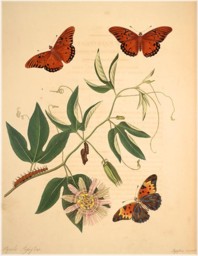A Passion for Passionflower
By Audrey Stallsmith

To Dorothea, still in that time of youth when the eyes with their long full lashes look out after their rain of tears unsoiled and unwearied as a freshly opened passion-flower. . .
Middlemarch, George Eliot
While we all still have Easter in mind, I'm going to talk about a bloom that derived its name from the holiday (literally "holy day"). Yes, the passionflower was named for Christ's sufferings, not for its ability to inflame desire. In fact, since passiflora is a sedative, it's more likely to put you to sleep!
The plant's peculiar and showy flowers were once thought to represent the crucifixion, though some of the comparisons that were thrown around seemed to stretch things a bit! For instance, to make the 10 petals stand for the apostles, you have to discount the two who supposedly weren't present at Calvary (Judas and Peter). So, in the Language of Flowers, the plant came to stand for "religious superstition."
According to Brewer's Phrase and Fable, "the leaf symbolizes the spear; the five anthers, the five wounds; the tendrils, the cords or whips; the column of the ovary, the pillar of the cross; the stamens, the hammers; the three styles, the three nails; the fleshy threads within the flowers, the crown of thorns; the calyx, the glory or nimbus; the white tint, purity; and the blue tint, heaven." The blooms supposedly stay open three days also, and so could indicate either the time between the crucifixion and resurrection or the three years of Christ's ministry.
Nicholas Monardes, a Spanish doctor, introduced a Peruvian passiflora to Europe in the mid-1500's. He believed its blooms pronounced God's blessing on the forced conversion of the Incas to Christianity.
That was, we can safely conclude, only wishful thinking on his part. But at least the plant has proved to be a blessing of sorts to the rest of the world. The Japanese see something different in its face, calling it "clock flower."
The type most frequently used for medicinal purposes is Passiflora incarnata. Passiflora literally means "passion flower," while "incarnata" indicates a "flesh color"--or, presumably, the Incarnation itself. The plant's flesh-colored flowers are tinged with purple, and it bears orange fruit. This type grows wild in much of the southern U.S., where it is known as maracoc, apricot vine, or maypop. (In those parts, it usually blooms in May.)
Medicinally, Passiflora incarnata is most frequently used as a sedative to calm the nerves. Since it's not narcotic, it doesn't generally cause addictions. Because it's also a muscle relaxant, it can relieve menstrual cramps and some digestive problems.
Although passiflora's effect is mostly soothing, it does contain harmala chemicals that dilate blood vessels, possibly helping fend off heart disease. Those chemicals also stimulate the uterus, however, so pregnant women shouldn't consume passionflower. The crushed leaves of the plant have also been applied as a poultice for cuts and bruises.
Since they can't generally survive temperatures below 15 degrees, passifloras must be taken indoors for the winter in the north. In The Fragrant Path, Louise Beebe Wilder comments that Passiflora caerulea ("blue passionflower") "is usually a greenhouse subject but I remember that it was hardy in our Maryland garden though it was killed back to the crown every winter.
"It was an object of great awe amongst the children because of the dramatically revealed significance of its parts by our Irish Catholic nursemaids. . .In an old Spanish tradition it was the Passion Flower that climbed the Cross and fastened upon the scars in the wood where the nails had been driven through the hands and feet of the Sufferer."
How many passionflower types there are seems to be anybody's guess. Those estimates generally range between 300 and 600! Some of the better known are Passiflora quadrangularis (AKA granadilla), maliformis (AKA sweet calabash), and laurifolia (AKA water lemon).
Those three, like incarnata, produce edible fruits. But the Passiflora caerulea mentioned by Wilder is supposed to contain some form of cyanide. And many other types have toxic parts. So it's always a good idea to check up on the edibility of any variety you wish to consume!
Passifloras also play host to a variety of butterflies and moths, including fritillaries, the zebra longwing, and the Julia moth. It's best to ascertain, however, which passionflower is preferred by the type of flutter-by you wish to attract.
Although passiflora is not physically addictive, many plant collectors do develop a "passion" for this fascinating vine. But we gardeners don't really require the symbolism associated with it to remind us of God's love. We can see that in every flower we grow!
Image is from The Natural History of the Rarer Lepidopterous Insects of Georgia by James Edward Smith and John Abbot, courtesy of the Missouri Botanical Garden Library.








